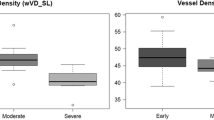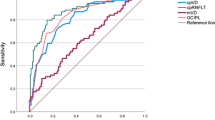Abstract
Purpose
To investigate a novel optical coherence tomography (OCT)-derived variable, circumpapillary mean retinal shadow width (cpMRSW), and to elucidate its association with normal-tension glaucoma (NTG).
Methods
For the purpose of validation, we measured retinal vascular calibers in 68 arterioles and 100 venules of 12 NTG patients and 12 healthy subjects and compared the width of the visible retinal shadows in spectral-domain OCT images and the caliber of retinal vessels in retinal photographs. Then we calculated cpMRSW in 78 NTG eyes and 25 age-matched healthy control eyes. Additionally, we divided the patients into early (mean deviation: MD > −6 dB), moderate (MD −6 to −12 dB), and severe (MD < −12 dB) NTG groups, and compared cpMRSW in these groups. Finally, we calculated the area under the receiver operating characteristic (ROC) curve in order to determine the power of mean retinal shadow width to distinguish the groups.
Results
OCT retinal shadow width was significantly correlated with photography-measured retinal caliber (r = 0.82, P < 0.001). CpMRSW was significantly different between the control and NTG patients (control: 107.3 ± 7.0 µm, mild: 99.4 ± 8.6 µm, moderate: 99.7 ± 9.5 µm, severe: 90.5 ± 12.0 µm, P < 0.001), despite similar distributions in systemic variables. An ROC analysis revealed that cpMRSW could differentiate NTGs from normal eyes (area under the ROC curve: 0.81).
Conclusions
Our new software for measuring mean retinal shadow width in OCT images may be a valuable tool for detecting NTG and diagnosing its severity.






Similar content being viewed by others
References
Quigley HA, Broman AT. The number of people with glaucoma worldwide in 2010 and 2020. Br J Ophthalmol. 2006;90:262–7.
Collaborative Normal-Tension Glaucoma Study Group. The effectiveness of intraocular pressure reduction in the treatment of normal-tension glaucoma. Am J Ophthalmol. 1998;126:498–505.
Kass MA, Heuer DK, Higginbotham EJ, Johnson CA, Keltner JL, Miller JP, et al. The Ocular Hypertension Treatment Study: a randomized trial determines that topical ocular hypotensive medication delays or prevents the onset of primary open-angle glaucoma. Arch Ophthalmol. 2002;120:701–13 (discussion 829–30).
Heijl A, Leske MC, Bengtsson B, Hyman L, Hussein M. Reduction of intraocular pressure and glaucoma progression: results from the Early Manifest Glaucoma Trial. Arch Ophthalmol. 2002;120:1268–79.
Musch DC, Gillespie BW, Lichter PR, Niziol LM, Janz NK. Visual field progression in the Collaborative Initial Glaucoma Treatment Study the impact of treatment and other baseline factors. Ophthalmology. 2009;116:200–7.
Flammer J, Orgul S, Costa VP, Orzalesi N, Krieglstein GK, Serra LM, et al. The impact of ocular blood flow in glaucoma. Prog Retin Eye Res. 2002;21:359–93.
Leske MC. Ocular perfusion pressure and glaucoma: clinical trial and epidemiologic findings. Curr Opin Ophthalmol. 2009;20:73–8.
Caprioli J, Coleman AL. Blood pressure, perfusion pressure, and glaucoma. Am J Ophthalmol. 2010;149:704–12.
Mitchell P, Leung H, Wang JJ, Rochtchina E, Lee AJ, Wong TY, et al. Retinal vessel diameter and open-angle glaucoma: the Blue Mountains Eye Study. Ophthalmology. 2005;112:245–50.
Wang S, Xu L, Wang Y, Jonas JB. Retinal vessel diameter in normal and glaucomatous eyes: the Beijing eye study. Clin Exp Ophthalmol. 2007;35:800–7.
Amerasinghe N, Aung T, Cheung N, Fong CW, Wang JJ, Mitchell P, et al. Evidence of retinal vascular narrowing in glaucomatous eyes in an Asian population. Invest Ophthalmol Vis Sci. 2008;49:5397–402.
Kawasaki R, Wang JJ, Rochtchina E, Lee AJ, Wong TY, Mitchell P. Retinal vessel caliber is associated with the 10-year incidence of glaucoma: the Blue Mountains Eye Study. Ophthalmology. 2013;120:84–90.
Huang D, Swanson EA, Lin CP, Schuman JS, Stinson WG, Chang W, et al. Optical coherence tomography. Science. 1991;254:1178–81.
Fabritius T, Makita S, Hong Y, Myllyla R, Yasuno Y. Automated retinal shadow compensation of optical coherence tomography images. J Biomed Opt. 2009;14:010503.
Muraoka Y, Tsujikawa A, Kumagai K, Akiba M, Ogino K, Murakami T, et al. Age- and hypertension-dependent changes in retinal vessel diameter and wall thickness: an optical coherence tomography study. Am J Ophthalmol. 2013;156:706–14.
Fortune B, Reynaud J, Cull G, Burgoyne CF, Wang L. The effect of age on optic nerve axon counts, SDOCT scan quality, and peripapillary retinal nerve fiber layer thickness measurements in rhesus monkeys. Transl Vis Sci Technol. 2014;3:2.
Jaffe GJ, Caprioli J. Optical coherence tomography to detect and manage retinal disease and glaucoma. Am J Ophthalmol. 2004;137:156–69.
Shiga Y, Asano T, Kunikata H, Nitta F, Sato H, Nakazawa T, et al. Relative flow volume, a novel blood flow index in the human retina derived from laser speckle flowgraphy. Invest Ophthalmol Vis Sci. 2014;55:3899–904.
Knudtson MD, Lee KE, Hubbard LD, Wong TY, Klein R, Klein BE. Revised formulas for summarizing retinal vessel diameters. Curr Eye Res. 2003;27:143–9.
Hogan M, Alavarado J, Weddell JE. Histology of the human eye: an Atlas and Textbook. Philadelphia: W.B. Saunders Company; 1971.
Pakter HM, Fuchs SC, Maestri MK, Moreira LB, Dei Ricardi LM, Pamplona VF, et al. Computer-assisted methods to evaluate retinal vascular caliber: what are they measuring? Invest Ophthalmol Vis Sci. 2011;52:810–5.
Maekawa S, Shiga Y, Kawasaki R, Nakazawa T. Usefulness of novel laser speckle flowgraphy-derived variables of the large vessel area in the optic nerve head in normal tension glaucoma. Clin Exp Ophthalmol. 2014. doi:10.1111/ceo.12354.
Kaushik S, Kifley A, Mitchell P, Wang JJ. Age, blood pressure, and retinal vessel diameter: separate effects and interaction of blood pressure and age. Invest Ophthalmol Vis Sci. 2007;48:557–61.
Patel NB, Lim M, Gajjar A, Evans KB, Harwerth RS. Age-associated changes in the retinal nerve fiber layer and optic nerve head. Invest Ophthalmol Vis Sci. 2014;55:5134–43.
Wong TY, Knudtson MD, Klein R, Klein BE, Meuer SM, Hubbard LD. Computer-assisted measurement of retinal vessel diameters in the Beaver Dam Eye Study: methodology, correlation between eyes, and effect of refractive errors. Ophthalmology. 2004;111:1183–90.
Sun C, Liew G, Wang JJ, Mitchell P, Saw SM, Aung T, et al. Retinal vascular caliber, blood pressure, and cardiovascular risk factors in an Asian population: the Singapore Malay Eye Study. Invest Ophthalmol Vis Sci. 2008;49:1784–90.
Yanagi M, Misumi M, Kawasaki R, Takahashi I, Itakura K, Fujiwara S, et al. Is the association between smoking and the retinal venular diameter reversible following smoking cessation? Invest Ophthalmol Vis Sci. 2014;55:405–11.
Acknowledgements
This paper was supported in part by JSPS KAKENHI Grants-in-Aid for Scientific Research (B) (T. N. 26293372) and for Exploratory Research (T. N. 26670751), and by the JST Center for Revitalization Promotion. The authors thank Morin Ryu, Tsutomu Kikawa, Akiko Matsumoto, Masahiro Akiba for providing technical support and valuable comment, and Tim Hilts for reviewing the manuscript.
Author information
Authors and Affiliations
Corresponding author
Ethics declarations
Conflicts of interest
T. Yabana, None; Y. Shiga, None; R. Kawasaki, None; K. Omodaka, None; H. Takahashi, None; K. Kimura, None; K. Togashi, None; T. Horii, None; K. Sasaki, None; T. Yuasa, None; T. Nakazawa, None.
About this article
Cite this article
Yabana, T., Shiga, Y., Kawasaki, R. et al. Evaluating retinal vessel diameter with optical coherence tomography in normal-tension glaucoma patients. Jpn J Ophthalmol 61, 378–387 (2017). https://doi.org/10.1007/s10384-017-0523-z
Received:
Accepted:
Published:
Issue Date:
DOI: https://doi.org/10.1007/s10384-017-0523-z




